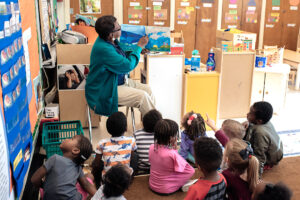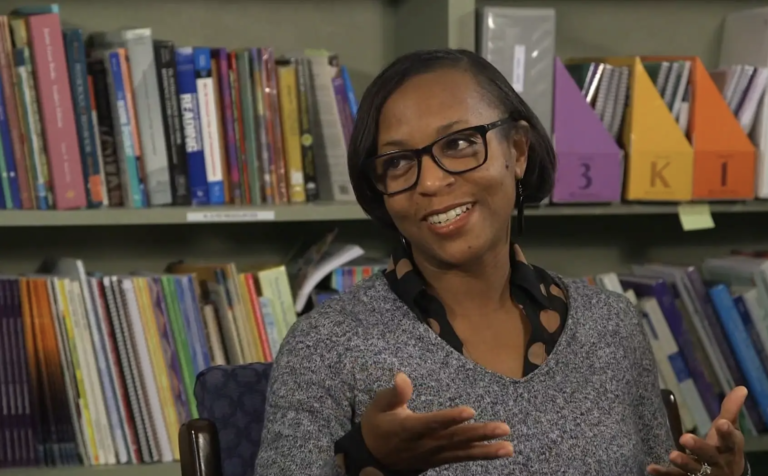Once upon a time.. and another time… and another time.
Haven’t you ever noticed how kids love reading the same book over and over again? The familiar rhythm of the words and pictures on a page – it seems children never get tired of it! But, did you know multiple reads isn’t just something kids like to do, but it’s actually key to building language and literacy? So, should you really use your valuable class time re-reading the same book? Yes, you should!
Next time you choose a storybook for your class, try reading your book three times using a strategy called START.
In just three read alouds, you can see your preschool and pre-K students go from merely listening to the stories, to understanding the characters and what they’re feeling – AND being able to communicate this with you in complex sentences. The key is to let each of the three read alouds focus on a different learning objective.
During Every Read Aloud: “START” with the Basics
Each time you read the book with your students, try following this pattern:
S – State the main idea and purpose
T – Teach the vocabulary and model critical thinking
A – Ask an open ended question at the end of the story
R – Respond to your children’s answers and other questions
T – Tie the main idea and purpose to a relatable topic of your children’s world
This is called the “START Strategy.” This technique will completely transform how you think about read alouds – and how your children will learn!
But how do we use this during each read aloud? Let’s find out!
Watch along! You can follow along with Mary as she reads the storybook “Owl Babies” to her Pre-K classroom.
First Read Aloud: Explain Key Events in the Story
 Ok, so you’re ready for your first read aloud! In this first read, you’re going to focus on explaining key events, characters, and how they’re related to one another. What’s the story about? What problems are the characters facing within the story? You want to make sure everyone understands what’s happening in the story.
Ok, so you’re ready for your first read aloud! In this first read, you’re going to focus on explaining key events, characters, and how they’re related to one another. What’s the story about? What problems are the characters facing within the story? You want to make sure everyone understands what’s happening in the story.
You’ll also want to introduce some complex vocabulary, or Tier 2, words. In Mary’s read of “Owl Babies,” she introduced the word “nocturnal” to her students because that helped them understand why the baby owls were awake at night. Knowing these complex, Tier 2 words allows for the child to have a better understanding of the story.
Wrap up your first read by recapping what happened during the story. But don’t stop there! Connect the story to an activity later in the day to help build comprehension and exposure to the vocabulary you just introduced. For example, make a habitat for the baby owls at your art center!
Are you feeling nervous about doing your first read aloud? Not to worry! You can use a story guide to help you prepare your first read through, so you can be ready to build children’s language during story time!

- Spark the children’s interest as you describe the book’s title and cover.
- Wait to ask the children questions until the end.
- Use think-alouds to model how to think about the book.
- At the end of the read aloud, create and ask open-ended questions that prompt thoughtful responses from students and encourage them to use target vocabulary.
- Always keep in mind you need to let children know their thoughts matter. Recognize their comments and engage with what they say.
Second Read Aloud: Focus on the Character’s Thoughts and Feelings
 We’re back again later in the week for story time for our second read aloud! The kids have already been exposed to this book once before, so it’s time to take story time to the next level. In this second read, the primary focus is on the characters’ thoughts and feelings.
We’re back again later in the week for story time for our second read aloud! The kids have already been exposed to this book once before, so it’s time to take story time to the next level. In this second read, the primary focus is on the characters’ thoughts and feelings.
Try using a technique called “think-alouds” to get into the minds of the characters in the books. Since the children are already familiar with the main events of the story, you can now move on to exploring the characters’ emotional state.
At the end of the story, engage with the children and ask them open-ended questions about the story. You can see that even by the second read, the children understand so much more!

- Before the read aloud, write key vocabulary and prompts to use on sticky notes.
- Make sure your open-ended questions focus around emotions and encourage your students to answer using your focus vocabulary.
- Always acknowledge children’s responses and build on their statements.
- Your classroom activity following the read should tie into the characters’ thoughts and feelings and be an opportunity to incorporate focus vocabulary.
Third Read Aloud: Build Comprehension and Thinking Skills
 Here we are again! This time we’re going to ask more questions to get students to respond about the key events in the story and the characters’ feelings. Essentially, the third read is where you give the story to the children and give them the opportunity to reconstruct the meaning.
Here we are again! This time we’re going to ask more questions to get students to respond about the key events in the story and the characters’ feelings. Essentially, the third read is where you give the story to the children and give them the opportunity to reconstruct the meaning.
In Mary’s third read, the kids are engaged and echoing back advanced vocabulary from previous reads such as “separate.” My, look how much they’ve learned!
By the third read, there’s not a whole lot of reading actually happening. While you may read some of the words on the page, you’re mostly allowing the children to tell you what happened in the story. It’s incredible to see how much the kids remember!

- Make this a conversation where you use open-ended questions to encourage children to respond and help guide them through their answers.
- Ask questions that give children the opportunity to respond using focus vocabulary.
- After each read aloud, the next classroom activity should tie into the main idea and allow children to use advanced vocabulary words taught during read aloud.
See, language building during story time is as easy as 1, 2, 3! So, just remember when you sit down to read your students’ favorite book again and again and again, you’re actually laying the foundation for literacy, reading, and all learning.
To learn more about the START strategy, and how to read books interactively with your students, take our free course “Transforming Story Time.”
Recommended Read Aloud Resources for Preschool & Pre-K Classrooms:
- START Planning Template
- Planning for START Reads
- START Planning Template
- START Checklist
- Tuning-In and Responsive Teaching for START Teaching Aid
- START Poster
- First START Read Teaching Aid
- Second START Read Teaching Aid
- Third START Read Teaching Aid
- Story Guides for Preschool & Pre-K Classrooms
- List of Sophisticated Storybooks Organized by Theme




A book being read with aloud 3 times can yield so much information to be pulled from each time you read the story. Using repetition to solidify the foundation, and continue to pull out different aspects of the story to build layers to unfold.
You are so right, Lynn. It is so important for building comprehension and vocabulary!